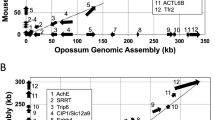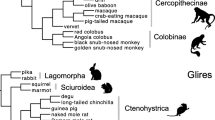Abstract
Rapid evolution has been identified for many reproductive genes and recent studies have combined phylogenetic tests and information on species mating systems to test sexual selection. Here we examined the molecular evolution of the ADAM gene family, a diverse group of 35 proteins capable of adhesion to and cleavage of other proteins, using sequence data from 25 mammalian genes. Out of the 25 genes analyzed, all those expressed in male reproductive tissue showed evidence of positive selection. Positively selected amino acids within the protein adhesion domain were only found in sperm surface ADAM proteins (ADAMs 1, 2, 3, 4, and 32) suggesting selection driven by male × female interactions. We tested heterogeneity in rates of evolution of the adhesion domain of ADAM proteins by using sequence data from Hominidae and macaques. The use of the branch and branch-site models (PAML) showed evidence of higher d N/d S and/or positive selection linked to branches experiencing high postmating selective pressures (chimpanzee and macaque) for Adams 2, 18, and 23. Moreover, we found consistent higher proportion of nonsynonymous relative to synonymous and noncoding sequence substitutions in chimpanzee and/or macaque only for Adams 2, 18, and 23. Our results suggest that lineage-specific sexual selection bouts might have driven the evolution of the adhesion sperm protein surface domains of ADAMs 2 and 18 in primates. Adams 2 and 18 are localized in chromosome 8 of primates and adjacent to each other, so their evolution might have also been influenced by their common genome localization.


Similar content being viewed by others
References
Blobel CP, Wolfsberg TG, Turck CW, Myles DG, Primakoff P, White JM (1992) A potential fusion peptide and an integrin ligand domain in a protein active in sperm–egg fusion. Nature 356:248–252
Cho C, Bunch DO, Faure JE, Goulding EH, Eddy EM, Primakoff P, Myles DG (1998) Fertilization defects in sperm from mice lacking fertilin beta. Science 281:1857–1859
Cho C, Ge H, Branciforte D, Primakoff P, Myles DG (2000) Analysis of mouse fertilin in wild-type and fertilin beta(−/−) sperm: evidence for C-terminal modification, alpha/beta dimerization, and lack of essential role of fertilin alpha in sperm–egg fusion. Dev Biol 222:289–295
Civetta A (2003a) Shall we dance or shall we fight? Using DNA sequence data to untangle controversies surrounding sexual selection. Genome 46:925–929
Civetta A (2003b) Positive selection within sperm–egg adhesion domains of fertilin: an ADAM gene with a potential role in fertilization. Mol Biol Evol 20:21–29
Civetta A, Singh RS (1998) Sex-related genes, directional sexual selection, and speciation. Mol Biol Evol 15:901–909
Clark NL, Aagaard JE, Swanson WJ (2006) Evolution of reproductive proteins from animals and plants. Reproduction 131:11–22
Dean MD, Good JM, Nachman MW (2008) Adaptive evolution of proteins secreted during sperm maturation: an analysis of the mouse epididymal transcriptome. Mol Biol Evol 25:383–392
Dixson AF (1998) Primate sexuality. Oxford University Press, Oxford
Dorus S, Evans PD, Wyckoff GJ, Choi SS, Lahn BT (2004) Rate of molecular evolution of the seminal protein gene SEMG2 correlates with levels of female promiscuity. Nat Genet 36:1326–1329
Dorus S, Wasbrough ER, Busby J, Wilkins EC, Karr TL (2010) Sperm proteomics reveals intensified selection on mouse sperm membrane and acrosome genes. Mol Biol Evol 27:1235–1246
Edwards DR, Handsley MM, Pennington CJ (2008) The ADAM metalloproteinases. Mol Aspects Med 29:258–289
Evans JP (2001) Fertilin β and other ADAMs as integrin ligands: insights into cell adhesion and fertilization. Bioessays 23:628–639
Evans JP (2002) The molecular basis of sperm–oocyte membrane interactions during mammalian fertilization. Hum Reprod Update 8:297–311
Felsenstein J (1985) Confidence-limits on phylogenies—an approach using the bootstrap. Evolution 39:783–791
Frayne J, Hall L (1998) The gene for the human tMDC I sperm surface protein is non-functional: implications for its proposed role in mammalian sperm–egg recognition. Biochem J 334:171–176
Frayne J, Dimsey EA, Jury JA, Hall L (1999) Transcripts encoding the sperm surface protein tMDC II are non-functional in the human. Biochem J 341:771–775
Frayne J, Hurd EAC, Hall L (2002) Human tMDC III: a sperm protein with a potential role in oocyte recognition. Mol Hum Reprod 8:817–822
Glassey B, Civetta A (2004) Positive selection at reproductive ADAM genes with potential intercellular binding activity. Mol Biol Evol 21:851–859
Good JM, Nachman MW (2005) Rates of protein evolution are positively correlated with developmental timing of expression during mouse spermatogenesis. Mol Biol Evol 22:1044–1052
Han C, Choi E, Park I, Lee B, Jin S, do Kim H, Nishimura H, Cho C (2009) Comprehensive analysis of reproductive ADAMs: relationship of ADAM4 and ADAM6 with an ADAM complex required for fertilization in mice. Biol Reprod 80:1001–1008
Hurle B, Swanson W, NISC Comparative Sequencing Program, Green ED (2007) Comparative sequence analyses reveal rapid and divergent evolutionary changes of the WFDC locus in the primate lineage. Genome Res 17:276–286
Huxley-Jones J, Clarke TK, Beck C, Toubaris G, Robertson DL, Boot-Handford RP (2007) The evolution of the vertebrate metzincins; insights from Ciona intestinalis and Danio rerio. BMC Evol Biol 7:63
Jury JA, Frayne J, Hall L (1997) The human fertilin alpha gene is non-functional: implications for its proposed role in fertilization. Biochem J 321:577–581
Jury JA, Frayne J, Hall L (1998) Sequence analysis of a variety of primate fertilin alpha genes: evidence for non-functional genes in the gorilla and man. Mol Reprod Dev 51:92–97
Kim T, Oh J, Woo JM, Choi E, Im SH, Yoo YJ, Kim DH, Nishimura H, Cho C (2006) Expression and relationship of male reproductive ADAMs in mouse. Biol Reprod 74:744–750
Kingan SB, Tatar M, Rand DM (2003) Reduced polymorphism in the chimpanzee semen coagulating protein, semenogelin I. J Mol Evol 57:159–169
Morgenstern B, Dress A, Werner T (1996) Multiple DNA and protein sequence alignment based on segment-to-segment comparison. Proc Natl Acad Sci USA 93:12098–120103
Nishimura H, Kim E, Nakanishi T, Baba T (2004) Possible function of the ADAM1a/ADAM2 fertilin complex in the appearance of ADAM3 on the sperm surface. J Biol Chem 279:34957–34962
Nishimura H, Myles DG, Primakoff P (2007) Identification of an ADAM2–ADAM3 complex on the surface of mouse testicular germ cells and cauda epididymal sperm. J Biol Chem 282:17900–17907
O’Connor TD, Mundy NI (2009) Genotype–phenotype associations: substitution models to detect evolutionary associations between phenotypic variables and genotypic evolutionary rate. Bioinformatics 25:i94–i100
Oh J, Woo JM, Choi E, Kim T, Cho BN, Park ZY, Kim YC, Kim DH, Cho C (2005) Molecular, biochemical, and cellular characterization of epididymal ADAMs, ADAM7 and ADAM28. Biochem Biophys Res Commun 331:1374–1383
Panhuis TM, Clark NL, Swanson WJ (2006) Rapid evolution of reproductive proteins in abalone and Drosophila. Philos Trans R Soc Lond B Biol Sci 361:261–268
Primakoff P, Myles DG (2000) The ADAM gene family: surface proteins with adhesion and protease activity. Trends Genet 16:83–87
Primakoff P, Myles DG (2007) Cell–cell membrane fusion during mammalian fertilization. FEBS Lett 581:2174–2180
Ramm SA, Oliver PL, Ponting CP, Stockley P, Emes RD (2008) Sexual selection and the adaptive evolution of mammalian ejaculate proteins. Mol Biol Evol 25:207–219
Shamsadin R, Adham IM, Nayernia K, Heinlein UAO, Oberwinkler H, Engel W (1999) Male mice deficient for germ–cell cyritestin are infertile. Biol Reprod 61:1445–1451
Suyama M, Torrents D, Bork P (2006) PAL2NAL: robust conversion of protein sequence alignments into the corresponding codon alignments. Nucleic Acids Res 34:W609–W612
Swanson WJ, Vacquier VD (2002) The rapid evolution of reproductive proteins. Nat Rev Genet 3:137–144
Swanson WJ, Nielsen R, Yang Q (2003) Pervasive adaptive evolution in mammalian fertilization proteins. Mol Biol Evol 20:18–20
Swofford DL (2003) PAUP*. Phylogenetic analysis using parsimony (*and other methods). Version 4. Sinauer Associates, Sunderland, Massachusetts
Tamura K, Dudley J, Nei M, Kumar S (2007) MEGA4: Molecular Evolutionary Genetics Analysis (MEGA) software version 4.0. Mol Biol Evol 24:1596–1599
Thompson JD, Gibson TJ, Plewniak F, Jeanmougin F, Higgins DG (1997) The CLUSTAL_X windows interface: flexible strategies for multiple sequence alignment aided by quality analysis tools. Nucleic Acids Res 25:4876–4882
Torgerson DG, Kulathinal RJ, Singh RS (2002) Mammalian sperm proteins are rapidly evolving: evidence of positive selection in functionally diverse genes. Mol Biol Evol 19:1973–1980
Wolfsberg TG, Primakoff P, Myles DG, White JM (1995) ADAM, a novel family of membrane proteins containing a disintegrin and metalloprotease domain: multipotential functions in cell–cell and cell–matrix interactions. J Cell Biol 131:275–278
Wong WSW, Yang Z, Goldman N, Nielsen R (2004) Accuracy and power of statistical methods for detecting adaptive evolution in protein coding sequences and for identifying positively selected sites. Genetics 168:1041–1051
Yamaguchi R, Muro Y, Isotani A, Tokuhiro K, Takumi K, Adham I, Ikawa M, Okabe M (2009) Disruption of ADAM3 impairs the migration of sperm into oviduct in mouse. Biol Reprod 81:142–146
Yang Z (1997) PAML: a program package for phylogenetic analysis by maximum likelihood. Comput Appl Biosci 13:555–556
Yang Z, Nielsen R (2002) Codon-substitution models for detecting molecular adaptation at individual sites along specific lineages. Mol Biol Evol 19:908–917
Yang Z, Goldman N, Friday A (1994) Comparison of models for nucleotide substitution used in maximum-likelihood phylogenetic estimation. Mol Biol Evol 11:316–324
Yang Z, Nielsen R, Goldman N, Pedersen AM (2000) Codon-substitution models for heterogeneous selection pressure at amino acid sites. Genetics 155:431–449
Yang Z, Wong WS, Nielsen R (2005) Bayes empirical bayes inference of amino acid sites under positive selection. Mol Biol Evol 22:1107–1118
Zhang J, Nielsen R, Yang Z (2005) Evaluation of an improved branch-site likelihood method for detecting positive selection at the molecular level. Mol Biol Evol 22:2472–2479
Zhu GZ, Gupta S, Myles DG, Primakoff P (2009) Testase 1 (ADAM 24) a sperm surface metalloprotease is required for normal fertility in mice. Mol Reprod Dev 76:1106–1114
Acknowledgment
This work was supported by funds from an individual Discovery grant (NSERC) to Alberto Civetta.
Author information
Authors and Affiliations
Corresponding author
Electronic supplementary material
Below is the link to the electronic supplementary material.
Rights and permissions
About this article
Cite this article
Finn, S., Civetta, A. Sexual Selection and the Molecular Evolution of ADAM Proteins. J Mol Evol 71, 231–240 (2010). https://doi.org/10.1007/s00239-010-9382-7
Received:
Accepted:
Published:
Issue Date:
DOI: https://doi.org/10.1007/s00239-010-9382-7




